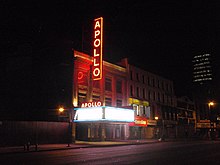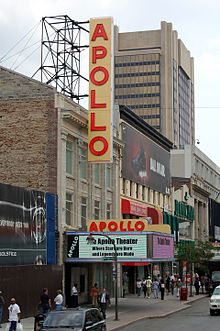Apollo Theater
![]()
This article refers to the Apollo Theater in Harlem, New York. For other meanings, see Apollo Theater.
The Apollo Theater at 254 West 125th Street in New York's Harlem neighborhood is one of the best-known venues for performing almost exclusively black music (jazz, blues, soul, pop and hip-hop) in the United States. The venue opened in 1914.
After a dance hall of the same name had already existed in New York since the 1870s, the theater on 125th Street (built in 1913) was a burlesque venue in the 1920s (Hurtig and Seamon's New Burlesque, only renamed the Apollo in 1928), but as was still customary at the time, it was only open to whites. In 1932, theatrical producer Sidney S. Cohen bought the Apollo. In 1934, Cohen opened the Apollo to African American audiences as well. By the early 1930s, the area's population was mixed (by contrast, by the mid-1930s it was already predominantly African American), and Cohen initially expected not only more audiences from this opening, but also savings on artists' fees by hiring black performers. After Cohen's death in 1935, his partner Morris Sussman, along with Frank Schiffman, who already ran the Harlem Opera House, took over the theater, which had rows of balconies and a total seating capacity of about 2000. In the Harlem Renaissance of the pre-World War II era, it launched the careers of artists such as Ella Fitzgerald (who was immediately hired by Chick Webb after her Amateur Night performance), Sarah Vaughan, and Billie Holiday, who got their chance in the regularly scheduled Amateur Night shows. It had its peak as a performance venue for jazz music in the 1930s and 1940s when musicians like Duke Ellington, Louis Armstrong, Count Basie performed here. In 1950 Nat King Cole performed at the Apollo (and was photographed in his dressing room by French photographer Éric Schwab reading Ebony magazine). The audience was at times very critical - chasing Lena Horne off stage, for example, by throwing pennies at her. Later, it was also the performance venue of numerous Motown artists such as Diana Ross, the Jackson 5 and the Supremes, and soul musicians such as Marvin Gaye and James Brown. Brown was laid to rest at the Apollo after his death in 2006.
The club began its decline in the 1960s, closing in the late 1970s. In 1983, the building received landmark status and reopened in 1985 with a televised gala Motown Salutes the Apollo. In 1991, it was purchased by the State of New York, and from 1992 onward, it was run by the nonprofit Apollo Theater Foundation. It also hosts regular events for up-and-coming talent Showtime at the Apollo and Apollo Amateur Night every Wednesday. A first phase of extensive restoration began in December 2005.
After the death of Michael Jackson, thousands of fans gathered at the Apollo Theater. It was one of the first stops in Michael Jackson's career (along with his family as The Jackson Five). He participated in and won Amateur Night in the late 1960s.
The theater also serves as a backdrop for film premieres (e.g. Downtown - A street tale) and political events such as Bill Clinton's 2002 Democratic National Committee fundraiser.
It is one of the main sights in Harlem and is open to visitors for historical tours.

Apollo Theater by night

Apollo Theater in Harlem
Search within the encyclopedia